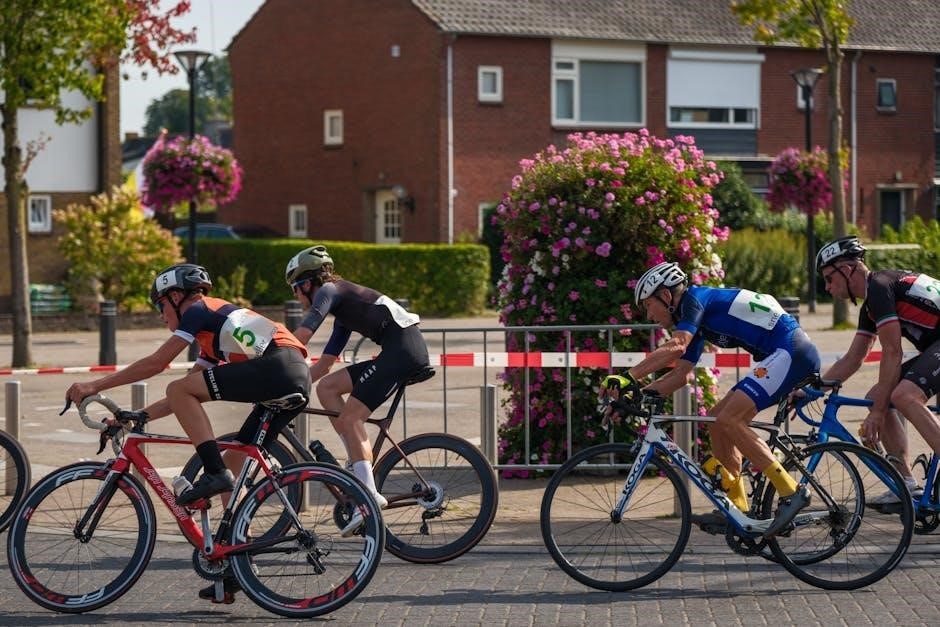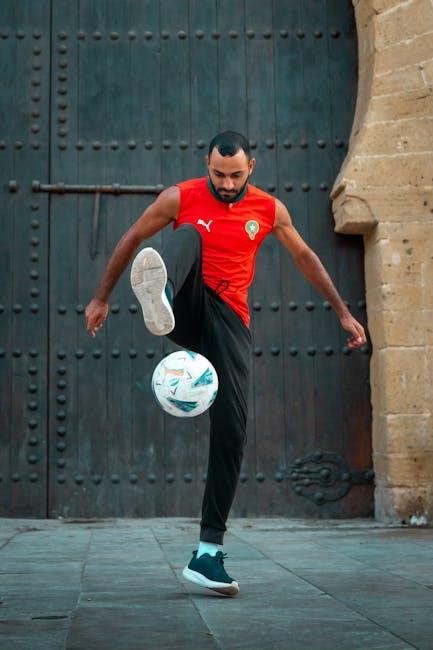Clyde Hart is a renowned coach known for his holistic approach to 400m training, blending speed, endurance, and mental toughness, with proven success at Baylor University.
1.1 Who is Clyde Hart?
Clyde Hart is a highly respected track and field coach, best known for his expertise in the 400-meter event. As the head coach at Baylor University, he has developed a reputation for producing elite athletes, including Olympic medalists. Hart’s coaching philosophy emphasizes a balance between speed, endurance, and mental preparation. His training methods, detailed in his 60-page manual, have been widely adopted and praised for their effectiveness. Hart’s success with athletes like Michael Johnson highlights his ability to optimize performance, making him a legendary figure in track and field coaching.
1.2 Key Principles of Clyde Hart’s Training Methodology
Clyde Hart’s training methodology centers on balancing speed and endurance, with a focus on periodization. He emphasizes building an aerobic base, gradually increasing intensity, and incorporating race-specific drills. Hart stresses the importance of mental toughness, pacing, and lactate threshold training. His approach avoids excessive volume, prioritizing quality over quantity, ensuring athletes peak during key competitions. Hart’s methods are tailored to individual needs, fostering both physical and psychological development. This holistic strategy has proven successful, producing elite 400m runners capable of sustaining high speeds while managing fatigue effectively.

1.3 The Importance of the 400m Event in Track and Field
The 400m dash is a unique event requiring a blend of sprinter speed and endurance runner stamina, making it one of track and field’s most demanding races. It serves as a bridge between sprints and middle-distance events, testing an athlete’s ability to sustain high speeds over a longer distance. The 400m is also pivotal in relays, often determining team outcomes. Its difficulty and strategic depth make it a cornerstone of track and field, attracting top talent and showcasing exceptional athleticism and mental fortitude. The event’s prestige is underscored by its inclusion in major championships, highlighting its significance worldwide.
The Science Behind Clyde Hart’s 400m Training
Clyde Hart’s training emphasizes lactic acid threshold, speed-endurance balance, and periodized workouts, scientifically tailored to meet the 400m’s unique physiological demands, ensuring optimal performance and athlete development.
2.1 Physiological Demands of the 400m Dash
The 400m dash requires a unique blend of speed and endurance, demanding high anaerobic capacity, rapid energy production, and efficient lactic acid management. Athletes must sustain near-maximum effort over 40-50 seconds, relying heavily on both the ATP-PC and glycolytic systems. Muscular strength, power, and endurance are critical, as fatigue and metabolic byproducts like lactic acid accumulate quickly. Proper training maximizes these physiological responses, ensuring peak performance and minimizing exhaustion; Clyde Hart’s methods address these demands through structured, science-backed workouts.
2.2 Balancing Speed and Endurance in Training

Clyde Hart’s program emphasizes blending speed and endurance through periodized training, ensuring athletes avoid overtraining. Sprint-focused workouts enhance raw speed, while endurance sessions build stamina. Hart integrates short, intense runs with longer, tempo-based efforts to maximize both energy systems. This balanced approach prevents athletes from becoming too specialized in one area, fostering versatility. By alternating between speed and endurance phases, Hart ensures runners peak when it matters most, maintaining optimal performance throughout the season.
2.3 The Role of Lactic Acid Threshold in 400m Training
Clyde Hart’s training incorporates workouts targeting the lactic acid threshold, enhancing an athlete’s ability to buffer and clear lactate during high-intensity efforts. This is crucial for 400m runners, as the event demands sustained speed while managing metabolic byproducts. Hart achieves this through specific speed-endurance sessions, such as 300m repeats at race pace, designed to improve lactate tolerance. By elevating the threshold, athletes can maintain faster paces longer, delaying fatigue and improving overall performance in the 400m dash.

Structure of Clyde Hart’s 400m Training Program
Clyde Hart’s program is structured around macrocycles and microcycles, with periodized training phases that balance speed and endurance development, ensuring peak performance at key competitions.
3.1 Macrocycle and Microcycle Planning
Clyde Hart’s training program is organized into macrocycles, which span the entire season, and microcycles, detailing weekly workouts. The annual plan is divided into phases: foundation building, intensity development, and competition preparation. Each macrocycle focuses on specific goals, such as enhancing endurance or increasing speed. Microcycles break these goals into manageable, week-long plans, ensuring a balance between aerobic and anaerobic training. Hart emphasizes periodization to avoid overtraining, with each phase building on the previous one to achieve peak performance during key competitions.
3.2 Periodization of Training Phases
Clyde Hart structures his training into distinct phases, each with specific objectives. The off-season focuses on building foundational endurance and strength, while the pre-season shifts to speed development and lactate threshold work. During the competition phase, workouts are tailored to enhance race-specific skills and mental preparation. Hart emphasizes gradual progression, ensuring athletes peak at major events. This periodized approach prevents overtraining and ensures optimal performance when it matters most, aligning with the demands of the 400m event’s unique blend of speed and endurance.
3.3 On-Season vs. Off-Season Training Strategies
Clyde Hart distinguishes between on-season and off-season training, tailoring strategies to athlete needs. The off-season focuses on building aerobic capacity, strength, and foundational speed through high-volume, low-intensity workouts. In contrast, the on-season emphasizes speed endurance, race-specific drills, and mental preparation, with reduced volume but increased intensity. Hart ensures a gradual transition between phases, allowing athletes to peak during competition while avoiding overtraining. This strategic approach balances physical and mental demands, optimizing performance for the 400m event.
Specific Workouts in Clyde Hart’s Program
Hart’s program includes speed development, endurance building, and speed-endurance workouts. These sessions are designed to enhance both physical and mental capabilities for optimal 400m performance.
4.1 Speed Development Exercises
Clyde Hart’s speed development exercises focus on short, intense sprints and explosive drills. Athletes perform 30-50 meter dashes at maximum effort, followed by adequate rest. These workouts aim to improve acceleration and raw speed. Hart also incorporates resistance training, such as hill sprints, to build power; Dynamic warm-ups and cooldowns are emphasized to enhance flexibility and prevent injury. The goal is to refine neuromuscular coordination, enabling athletes to maintain top speed longer during races. These exercises are foundational for building the speed required for elite-level 400m performance.
4.2 Endurance Building Workouts
Clyde Hart’s endurance workouts for 400m runners include prolonged aerobic sessions to enhance stamina. Athletes perform continuous runs of 15-45 minutes at a steady-state pace, gradually increasing intensity. Hart emphasizes the importance of lactate threshold training through tempo runs and slow repeats. These workouts are designed to improve mitochondrial density and capillary growth, allowing for more efficient oxygen delivery and energy utilization. Over time, this builds the endurance needed to sustain high speeds over the entire 400m race, balancing speed with stamina effectively.
4.3 Speed-Endurance Training Sessions
Clyde Hart’s speed-endurance workouts bridge the gap between pure speed and stamina. These sessions, such as 300m repeats at race pace or 200m runs with short recoveries, aim to enhance an athlete’s ability to maintain velocity while fatigued. By incorporating tempo runs and lactate threshold exercises, Hart helps runners build resilience against lactic acid buildup. This phase is critical for teaching athletes to sustain high intensities over the 400m distance, ensuring they can execute race strategy effectively and maintain optimal speed in the final stages of the race.
Clyde Hart’s Approach to Race Strategy
Clyde Hart’s race strategy emphasizes understanding the runner’s type, setting optimal paces, and mental preparation, ensuring athletes execute effectively based on their strengths and race dynamics.
5.1 Understanding the Importance of Pacing
Clyde Hart stresses that pacing is critical for 400m success, as it balances speed and endurance. Proper pacing prevents energy wastage and ensures athletes maintain optimal speed throughout the race. Hart’s approach involves determining a runner’s type—sprinter or endurance—to tailor pacing strategies. He warns against excessive aerobic work, likening it to poor dietary habits. Effective pacing fosters race execution, enabling athletes to avoid early burnout and finish strong. This philosophy underscores the need for precise planning and mental discipline to master the 400m event.
5.2 Techniques for Maintaining Optimal Speed
Clyde Hart emphasizes specific techniques to sustain top speed, such as short sprints and hill repeats, which enhance explosive power and speed endurance. Periodization ensures athletes maintain velocity by balancing intense workouts with recovery. Strength training is integral, as it supports muscle power and endurance. Hart also advocates for mental strategies, like visualization, to maintain focus and form under fatigue. These techniques, rooted in his philosophy, help athletes preserve speed while building stamina, making them indispensable in his 400m training regimen.

5.3 Race Execution and Mental Preparation
Clyde Hart’s approach emphasizes mastering race execution through precise pacing and mental resilience. Athletes are taught to balance aggression with control, ensuring optimal speed distribution. Mental preparation involves visualization techniques, fostering confidence and focus. Hart stresses the importance of staying composed under pressure, allowing athletes to execute strategies flawlessly. His methods cultivate a competitive mindset, enabling runners to perform at their peak during races, making mental toughness a cornerstone of his training philosophy.

Strength and Conditioning in Clyde Hart’s Program
Clyde Hart’s program integrates weight training, plyometrics, and core exercises to build power, explosiveness, and stability, essential for 400m runners to enhance performance and prevent injuries.
6.1 Weight Training for 400m Runners
Clyde Hart emphasizes weight training as a cornerstone of his 400m program, focusing on exercises like squats and deadlifts to build lower body strength and power. He believes strength is foundational for speed, with a focus on progressive overload to enhance explosiveness. The program balances strength with technique, ensuring runners maintain flexibility and proper mechanics. Weight sessions are structured to avoid interference with technical or speed workouts, with a emphasis on recovery to prevent overtraining. This approach has been instrumental in producing elite-level athletes capable of sustaining high velocities over the 400m distance.
6.2 Plyometric and Explosive Training
Clyde Hart incorporates plyometric and explosive training to enhance power and speed for 400m runners. Exercises like box jumps and depth jumps are used to improve reactive strength, essential for maintaining velocity. These workouts are designed to bridge the gap between strength and speed, allowing athletes to apply force quickly and efficiently. Explosive drills are integrated into the training cycle to maximize power output without compromising technique. This approach ensures runners can sustain high intensity over the entire race, making it a critical component of Hart’s program for achieving elite performance.
6.3 Core Strength and Stability Exercises
Clyde Hart emphasizes core strength as a cornerstone of his training program, recognizing its role in stability, posture, and overall athletic performance. Exercises like planks, Russian twists, and medicine ball workouts are integral to building a robust core. These routines improve running efficiency by stabilizing the body during high-intensity efforts. A strong core also reduces the risk of injuries and enhances the transfer of power from the legs to the upper body. Hart’s approach ensures that athletes maintain proper form and generate maximum force, making core training indispensable for 400m success.
Recovery and Injury Prevention
Clyde Hart’s program prioritizes recovery through rest, nutrition, and injury prevention strategies, ensuring athletes maintain peak performance while minimizing risks of overtraining and damage.
7.1 The Role of Rest and Recovery
Clyde Hart emphasizes rest as a critical component of his training philosophy, likening it to deposits in a “training bank account.” Adequate recovery allows athletes to adapt to intense workouts, preventing overtraining and enhancing performance. Hart advocates for sufficient sleep, active recovery techniques like ice baths, and strategic rest days to ensure the body repairs and strengthens. Neglecting recovery can lead to decreased performance and increased injury risk, making it a cornerstone of his program for sustaining peak athleticism and longevity in 400m runners.
7.2 Injury Prevention Strategies
Clyde Hart prioritizes injury prevention through structured training and attention to detail. He advocates for proper warm-ups, dynamic stretching, and strength conditioning to build resilience. Hart emphasizes periodized training to avoid overloading athletes, ensuring gradual progression of intensity and volume. Additionally, he stresses the importance of addressing muscle imbalances and maintaining optimal technique during workouts. By integrating these strategies, Hart minimizes the risk of injuries, allowing athletes to train consistently and achieve peak performance in the 400m event without setbacks.
7.3 Nutrition and Recovery Techniques
Clyde Hart emphasizes the importance of proper nutrition to fuel performance and aid recovery. He recommends a balanced diet rich in carbohydrates, proteins, and healthy fats to meet energy demands. Hydration is stressed to prevent fatigue and maintain peak physical function. Post-workout recovery includes strategies like ice baths, stretching, and adequate sleep to repair muscles and replenish energy stores. Hart also advocates for mental recovery techniques, such as visualization and relaxation, to ensure athletes are mentally refreshed for the next training session.

Mental and Psychological Aspects of Training
Clyde Hart integrates mental preparation into his 400m training, emphasizing focus, resilience, and goal visualization to build psychological strength and enhance performance under pressure.
8.1 Building Mental Toughness
Clyde Hart emphasizes mental toughness as a cornerstone of his training philosophy. He believes that mental resilience is cultivated through consistent, challenging workouts and positive reinforcement. Hart encourages athletes to embrace discomfort during intense sessions, fostering a mindset that thrives under pressure. By simulating race-day conditions in practice, he helps athletes develop focus and composure. His approach also includes visualization techniques, allowing runners to mentally rehearse success and build confidence. This psychological preparation is integral to his program, ensuring athletes are equally strong in mind and body.
8.2 Visualization and Goal Setting
Clyde Hart integrates visualization and goal setting into his training to enhance athlete performance. He encourages runners to mentally rehearse races, envisioning success and overcoming challenges. This practice builds confidence and readiness. Hart also emphasizes setting specific, achievable goals, aligning training with clear objectives. By combining visualization with structured goal setting, athletes stay focused and motivated, ensuring each session contributes to peak performance. This mindset preparation is crucial for mastering the 400m event.
8.3 Managing Race Day Nervousness
Clyde Hart emphasizes mental preparation to manage race day nervousness. He teaches athletes to focus on execution rather than outcomes, using breathing techniques and mental rehearsal. By staying calm and trusting their training, runners can channel nervous energy into performance. Hart also encourages a pre-race routine to build consistency and confidence, ensuring athletes remain composed under pressure. This approach helps them stay focused and deliver their best effort, transforming nervousness into a competitive edge.

Case Studies and Success Stories
Clyde Hart’s program transformed a 49.xx 400m runner to 47.6, demonstrating its effectiveness. His methods have produced elite athletes and record-breaking performances, solidifying his legacy.

9.1 Athletes Trained by Clyde Hart
Clyde Hart has coached numerous elite athletes, including Olympic medalists and world-class sprinters. Notable athletes like Michael Johnson and Darold Williamson thrived under his guidance. His program transformed a 49.xx 400m runner into a 47.6-second athlete, showcasing its effectiveness. Hart’s ability to balance speed and endurance has produced multiple NCAA champions and record-breaking performances. His legacy is marked by the success of his athletes, who credit his training philosophy for their achievements. Hart’s impact extends beyond individual athletes, influencing the broader track and field community.
9.2 Notable Achievements and Records
Clyde Hart’s training methods have yielded remarkable achievements, including Olympic medals and world records. His athletes, like Michael Johnson and Darold Williamson, have dominated the 400m event. Baylor University’s 4x400m relay teams, under his guidance, consistently broke records and won NCAA championships. Hart’s program has produced multiple sub-45 second 400m runners, a testament to his innovative approach. His ability to merge speed and endurance training has redefined the sport, leaving a lasting legacy in track and field history.
9.3 Testimonials from Athletes and Coaches
Athletes and coaches praise Clyde Hart’s training methods for their effectiveness and innovation. Michael Johnson, a legendary sprinter, credits Hart’s program for his record-breaking performances. Other athletes, like Darold Williamson, highlight how Hart’s emphasis on speed, endurance, and mental toughness transformed their careers. Coaches nationwide have adopted his holistic approach, calling it a game-changer for 400m training. His ability to adapt techniques to individual needs has earned him widespread respect, solidifying his legacy as one of track and field’s most influential figures.

Adaptation of Clyde Hart’s Program for Different Athletes
Clyde Hart’s program is highly customizable, catering to sprinters, endurance runners, and youth athletes, ensuring each athlete’s unique needs and goals are met effectively.
10.1 Customizing Training for Sprinters vs. Endurance Runners
Clyde Hart’s program tailors training to an athlete’s strengths, distinguishing between sprinters and endurance runners. Sprinters focus on explosive power and speed development, while endurance runners emphasize aerobic capacity and stamina. Hart assesses each athlete’s potential, adapting workouts to enhance their specific abilities. For sprinters, this includes short, intense intervals and strength training, whereas endurance runners engage in longer, steady-state runs; This balanced approach ensures athletes develop the skills necessary for the 400m, blending speed and endurance seamlessly.
10.2 Adjustments for Youth and Collegiate Athletes
Clyde Hart’s program adapts to the developmental stage of athletes, ensuring youth and collegiate runners progress safely and effectively. Youth athletes focus on building foundational speed and endurance, with emphasis on proper technique and aerobic development. Collegiate athletes undergo more intense, specialized training, balancing strength and speed. Hart’s approach includes periodized phases, preventing overtraining and injury, while fostering long-term growth. This tailored methodology ensures athletes at all levels achieve their potential, whether transitioning from youth to collegiate or advancing within their collegiate careers.
10.3 Tailoring Workouts for Individual Needs
Clyde Hart emphasizes personalized training plans, tailoring workouts to each athlete’s strengths, weaknesses, and goals. He assesses whether an athlete is speed or endurance-based, then structures sessions accordingly. For speed-focused runners, explosive drills and short sprints are prioritized, while endurance athletes engage in longer, stamina-building exercises. Hart’s program also considers injury history and current fitness levels, ensuring a balanced approach that maximizes performance without overtraining. This individualized strategy fosters optimal development and helps athletes achieve peak performance tailored to their unique needs and aspirations.
Clyde Hart’s training philosophy revolutionized 400m coaching, blending speed, endurance, and mental toughness. His legacy continues to inspire athletes and coaches, proving his methods yield elite results.
11.1 Summary of Key Training Principles
Clyde Hart’s training emphasizes a balanced approach, blending speed, endurance, and strength. His methodology focuses on periodization, ensuring athletes peak at the right time. Key principles include speed-endurance workouts, lactic threshold training, and mental preparation. Hart stresses the importance of understanding each athlete’s unique needs, tailoring programs to suit sprinters or endurance runners. His holistic approach, combining rigorous on-track sessions with recovery and nutrition, has proven successful. By fostering mental toughness and discipline, Hart’s methods create resilient, high-performing athletes capable of excelling in the demanding 400m event.
11.2 The Legacy of Clyde Hart’s Training Methods
Clyde Hart’s training methods have left an indelible mark on track and field, particularly in the 400m event. His holistic approach, combining speed, endurance, and mental preparation, has influenced generations of coaches and athletes. Hart’s success with athletes like Michael Johnson and Baylor University’s teams underscores his program’s effectiveness. His detailed training manuals and seminars have become invaluable resources, shaping modern coaching practices. Hart’s legacy continues to inspire, proving his methods are timeless and adaptable, solidifying his place as one of the sport’s most respected figures.
11.3 Encouragement for Aspiring 400m Runners
Aspiring 400m runners can draw immense inspiration from Clyde Hart’s proven training philosophy. His methods, detailed in his 60-page manual, offer a clear path for athletes to improve. Hart’s success stories, like Michael Johnson’s, demonstrate the potential for dramatic progress. Dedication and consistency are key, as Hart’s program emphasizes gradual development. By following his structured approach, athletes can unlock their full potential. The 400m is a challenging event, but with Hart’s guidance, aspiring runners can embrace the journey, stay committed, and achieve their goals, transforming hard work into rewarding performances.

